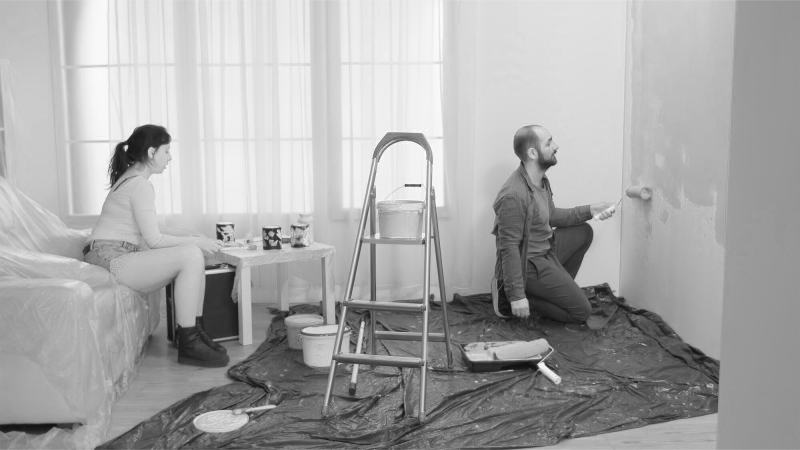Have you seen a house with different colors in every room? Or, have you seen one with the same tone, like all brown? If so, you’d probably think, “I would’ve picked a different color” or “I would’ve gone for a different theme.”
You see, color is both universal and personal. It’s in every house, sure. Some colors are widely accepted to be one thing or the other. But it also has personal meaning, depending on the homeowner’s preference.
You may think you’ll love your favorite colors all the time. But what if you wanted to make your home more exciting or more relaxing? Then, you start second-guessing your choices. Do the colors look good, or is it just you? Would your favorite colors work to achieve your desired effect?
If you’ve thought deeply about color, you’re on the right track. Color schemes do have a psychological influence on mood and comfort. So, how can you truly decide what color is best for your home? In this article, you will learn about that and more. So, read along to start making intentional color choices in your home.
The psychology of color in living spaces
The connection between colors and people can be traced back to Johann Wolfgang von Goethe’s idea in the 1800s. He speculated that colors can influence people’s emotions. For example, yellow was assumed to induce a lively and aspiring feeling, while blue induced anxiousness and restlessness. His proposition then initiates what you call the psychology of color.
Fast forward to today, psychology literature still explores how colors connect with emotions. But now you can find more detailed results.
For example, you may learn that red represents happiness, blue and green evoke calmness, while gray is connected to sadness. How can colors and emotions be connected? This is because certain colors evoke specific psychological responses. For example, people often match more chromatic colors (colors with more hue) to joy, while the least chromatic ones to sadness.
But there is also another reason. Colors are thought to have symbolic meanings. People can have different impressions about color because of the different contexts, like work, culture, or previous life events. For example, you might see red as a symbol of love, but others can see it as a sign of anger. So, individual backgrounds also influence how colors connect to certain emotions.
Now, what about color in the interior of your home? Psychology literature has also explored how colors in walls, furniture, and lighting affect homeowners’ moods and comfort. For example, it is known to use a calming color like blue in relaxing rooms to ensure that the colors complement the room’s function.
Look at the next section to see how to use different color schemes for your home.
Single color schemes
A single or monochromatic color scheme is a combination of just one color. It explores various shades of that color, such as using both lighter and darker versions. For example, you could alternate the shades on the wall or your furniture.
But why choose only one color? Read below to learn the benefits of monochromatic design.
Benefits of monochromatic design
The power of monochromatic color schemes lies in their simplicity. A single-color scheme can instantly create a harmonious environment, making your space look well put together. It also provides visual comfort to the beholder, elevating the relaxing and comfortable nuance of your home.
This also improves clarity. There is only one color to focus on and look around, eliminating the distractions of having different colors in every corner.
Finally, the monochromatic home design offers more flexibility. By alternating between shades, you can add depth, and you can even play with textures of the same color—all without risking overwhelming the space.
Psychological drawbacks of single colors
However, choosing one color can create a lack of visual interest. Even if you play with the light and dark shades, your space can look monotonous. It can also look boring because no other vibrant colors are available throughout the home.
Moreover, you need to carefully choose the dominant color. If you choose colors with less hue, you can evoke unwanted emotions. For example, you might favor neutral colors like gray or black, but certain shades of them can instead create fear or sadness inside your home.
Best applications for single-color schemes
So, when do you use single color schemes?
Since its advantage is creating comfort, it can be used in spaces where people relax, rest, or focus. Instead of applying the scheme throughout the house, it can be used in bedrooms, bathrooms, and meditation spaces.
For bedrooms, use calming colors like purple, blue, or brown to support sleep. If you like bold colors, like red or yellow, incorporate them as accents, for example, in the upholstery or lampshade. Choose lighter shades to ensure calming effects. You can also use these colors in your meditation room.
For bathrooms, you can use white, blue, or green. These colors can give a fresh and clean look and create a relaxing ambiance. Stick to lighter shades as well to maintain adequate light inside. If you prefer darker shades, use them in the accessories instead.
Now that you know about monochromatic home design, you may wonder how to be playful with colors in your home. Read along the next section to learn multiple color schemes.
Multiple color schemes
Multiple color schemes are a combination of two or more colors. Usually, you choose the complementary or analogous ones. Complementary represents opposite colors in the color wheel, like yellow and purple. Analogous means adjacent colors, like red and orange.
These schemes can differentiate rooms or separate walls from furniture. Below are the other benefits of multiple color schemes:
Benefits of multiple colors
Multiple color schemes can help you create a vibrant home. For example, you can have an energetic space by combining uplifting colors like yellow and green.
As mentioned, you can also use this color scheme to differentiate spaces. Use different colors for different rooms, or you can separate zones in one room to accommodate different activities.
Moreover, this scheme offers you endless possibilities. You can freely express yourself by using all of your favorite colors in various spaces. Additionally, you can choose wherever you want the diverse colors present, like in the walls, floors, lighting, or furniture.
All of these support you to show your personality through your home.
Read more: How to Create Multifunctional Spaces in Your Home
Psychological challenges of multiple colors
But, having various colors can easily lead to visual fatigue. Like watching a movie with abundant colors, your eyes can easily be tired and strained. Poorly planned combinations also make your home look too overwhelming.
You may also encounter difficulties balancing harmony since there are many colors involved. Although you might have planned the schemes for each room perfectly, they might clash if you look at your home as a whole. This can disrupt the aesthetic flow and create a chaotic atmosphere instead.
Best applications for multiple color schemes
So, when do you use multiple color schemes? Since its power lies in creating a dynamic space, you can use it in the rooms where your main activities occur. Use this scheme in the living room, dining room, and kitchen. Multiple colors are best to encourage more activities and interaction in those rooms.
Orange, brown, and beige are warm colors that can provide a sense of togetherness and stimulate conversation in the living room. The warm tone eliminates distractions and provides comfort instead. You can also use these colors in the dining room, in addition to red and yellow in the utensils or furniture. Both of these colors are known to stimulate appetite.
You can use the same color schemes as the dining room in the kitchen, but add white and gray to give it a hygienic look. This is because the kitchen is where you prepare food and wash dishes. You can use white and gray on the walls or cabinets.
Factors to consider when choosing colors in your home
Choosing colors for the living spaces includes paying attention to your own home. You must consider the room’s function and the intended ambiance. These factors will help you solidify your choices of colors and help you create an aesthetically comfortable home.
Keep reading to see how each factor plays a role.
Functions of the room
Certain activities are better when the surroundings have the same ambiance. For example, you might want to play more in a fun environment and relax more in a calming space. This is why the room’s function is essential when choosing color schemes.
As you have learned, specific color approaches can benefit rooms for sleeping and gathering. Using calming colors in the rooms where you sleep can help you relax better. Uplifting colors in the main rooms can also help. Bright colors can stimulate you to engage more in the activities and the person you’re with.
Natural light and space
The amount of natural light entering your house can also influence your choice of colors and schemes. If there’s no adequate light, you must consider lighter colors for single or multiple schemes you want to use. This is to ensure you have clear vision in the room.
Besides natural light, your available space can also influence your choices. You can make your space even smaller with darker colors. Consider how you want your color schemes to be perceived in various space sizes.
Emotional goals for the space
Although each room in your house has a clear function assigned to it, you might have a multi-functional room or prefer a different function than usual. For example, you might have your bedroom and workspace in one space or use your kitchen as your dining room. In this case, you need to set the emotional ambiance you want.
Take the bedroom and the workplace, for example. You might want one room to be relaxing and stimulating. To achieve this, you can use multiple color schemes, starting with calming colors to dominate the space and stimulating colors in the workspace corner.
Read more: Improve Your WFH Performance With Interior Color
Personal preferences and color associations
When all other factors are considered, you must ensure that the color choices are the ones you personally resonate with. After all, you’re the one who’s going to experience the colors every day. Instead of following the trends, it’s always better to go with your favorite.
You can play with the schemes or the placement of your favorite colors to make it work.
For example, if you prefer darker colors, use them as an accent color or in the furniture to maintain the ambiance of lighter colors. If you want to be playful but are reluctant to use various colors, you can use the single color scheme and play with the different shades it provides.
Color psychology for families
Last but not least, consider the other family members residing in the house. Your partner or children may have different preferences in colors or schemes. Discussing how to make the choices together ensures your whole family will enjoy the colors and that the family’s personality is reflected in the home.
In conclusion
Color schemes affect the mood and ambiance of your home.
Choosing which is best includes considering your home, your preferences, and the emotional goals you want to achieve. You can go for simplicity with the monochromatic design or optimize your expression with the multiple color scheme. The key is to ensure that your aim and the functional needs are aligned.
Now that you know the answer to choosing the best color for your home, you can start creating spaces that support your lifestyle through colors.
If you would like to see more resources on color utilization, check out the Home Organization Science Labs. The lab uses the research of the Institute for Life Management Science to produce courses, certifications, podcasts, videos, and other tools. Visit the Home Organization Science Labs today.
Photo by DC Studio on Freepik


